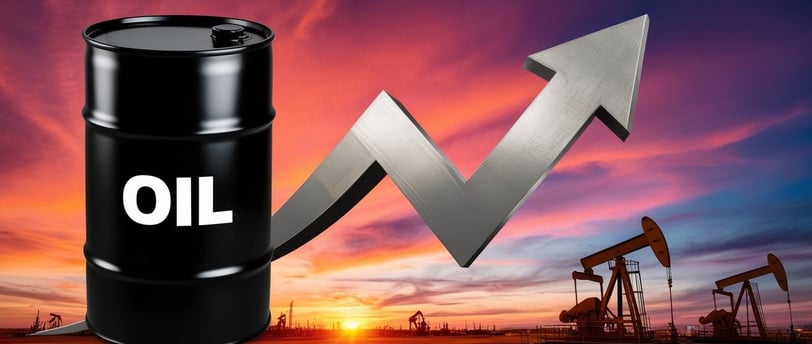Oil Prices Steady Amid Anticipation of Trump Announcements
Oil prices remained steady on Monday as traders awaited President-elect Donald Trump's inauguration and anticipated policy announcements. Brent crude futures fell by 0.46% to $80.42 a barrel, while U.S. West Texas Intermediate (WTI) crude dropped 0.31% to $77.64. Market attention is focused on potential executive orders, particularly whether Trump will relax energy sanctions on Russia in exchange for an end to the Russia-Ukraine war. Analysts also speculate that Trump might lift the moratorium on U.S. LNG export licenses, potentially boosting the energy sector. Despite this uncertainty, oil prices gained over 1% last week, marking a fourth consecutive weekly rise, largely driven by sanctions on Russian oil producers. These sanctions led to a rush for oil cargoes from China and India, which affected supply dynamics. However, analysts warn that the recent price gains could be short-lived if Trump eases sanctions or shifts geopolitical policies. Tensions in the Middle East also contributed to price stability, with a recent ceasefire between Hamas and Israel. Trump's previous policies in his first term saw the U.S. become the largest oil producer, and he pushed for deregulation and increased domestic drilling. As Trump’s second term begins, markets are eager to see how his energy policies evolve, especially regarding sanctions, LNG exports, and geopolitical negotiations.
ENERGY & TRANSPORTATIONWORLD ECONOMY


Oil prices remained steady on Monday as traders eagerly awaited the inauguration of U.S. President-elect Donald Trump and his upcoming policy announcements. Brent crude futures dropped by 0.46%, settling at $80.42 a barrel, while U.S. West Texas Intermediate (WTI) crude futures saw a smaller decline of 0.31%, trading at $77.64. The market's focus was on the potential executive orders that Trump might sign during his first hours in office, with many anticipating shifts in his stance toward energy policies.
One of the key issues on the table is the possibility that Trump will relax energy-related sanctions on Russia in exchange for an end to the ongoing Russia-Ukraine conflict. Analysts, including Giovanni Staunovo from UBS, noted that market participants were hoping for clarity on how the new administration's approach could affect oil production and supply dynamics. In addition to this, there is speculation that Trump may lift the moratorium on U.S. liquefied natural gas (LNG) export licenses, a move that could help bolster the U.S. energy sector and strengthen the economy.
Despite these uncertainties, the oil market saw some positive momentum last week. Both Brent and WTI crude benchmarks posted gains of over 1%, marking a fourth consecutive weekly increase. This was partly driven by the Biden administration's sanctions on Russian tankers and oil producers, which led to a scramble by China and India for prompt oil cargoes. However, analysts caution that these price gains may be short-lived if Trump's policies lead to a relaxation of sanctions or a shift in geopolitical tensions, particularly in Russia and the Middle East.
The easing of tensions in the Middle East, particularly with the recent ceasefire between Hamas and Israel, also contributed to keeping oil prices relatively stable. Although the market continues to monitor these developments, it is clear that much of the oil price movement is linked to geopolitical factors and expectations surrounding the incoming U.S. administration's stance on global energy and security issues.
Historic Data from Trump’s First Term:
During Donald Trump's first term as president (2017-2021), his policies had a notable impact on the global oil market. Trump's administration pursued an "America First" energy strategy that prioritized increasing U.S. domestic production of oil and gas. Under his leadership, the U.S. became the world's largest oil producer, surpassing both Russia and Saudi Arabia.
One of the key moments that influenced oil prices during Trump's tenure was his decision to withdraw the U.S. from the 2015 Paris Agreement on climate change in 2017. This move was seen as a signal that the U.S. would not enforce stringent environmental policies, which had implications for both fossil fuel production and global climate initiatives.
Trump also implemented significant deregulation in the energy sector, including easing restrictions on drilling and allowing expanded exploration in previously protected areas. These actions led to a boom in U.S. shale oil production, helping drive down global oil prices in the short term. However, by 2020, oil prices experienced extreme volatility due to the COVID-19 pandemic and a price war between Russia and Saudi Arabia, which caused crude prices to plummet to historic lows.
In terms of sanctions, Trump's administration took a tough stance on major oil-producing countries like Iran and Venezuela. U.S. sanctions on Iran significantly reduced the country's oil exports, tightening global supply and pushing prices higher. Conversely, Trump's policies aimed at increasing U.S. oil exports and pushing for energy independence were seen as having a positive effect on U.S. oil companies.
The culmination of these policies led to significant price swings during Trump's tenure. While crude prices fell to historic lows during the pandemic, the recovery in the latter half of 2020 was partly attributed to expectations of a pro-energy agenda under a new administration and the economic recovery.
As Trump’s second term begins, traders and analysts will be watching to see how his past policies are revived or modified, particularly in relation to the Russia-Ukraine war, LNG exports, and his stance on sanctions. With a focus on achieving energy dominance, Trump's influence on the global oil market remains a key point of interest.
